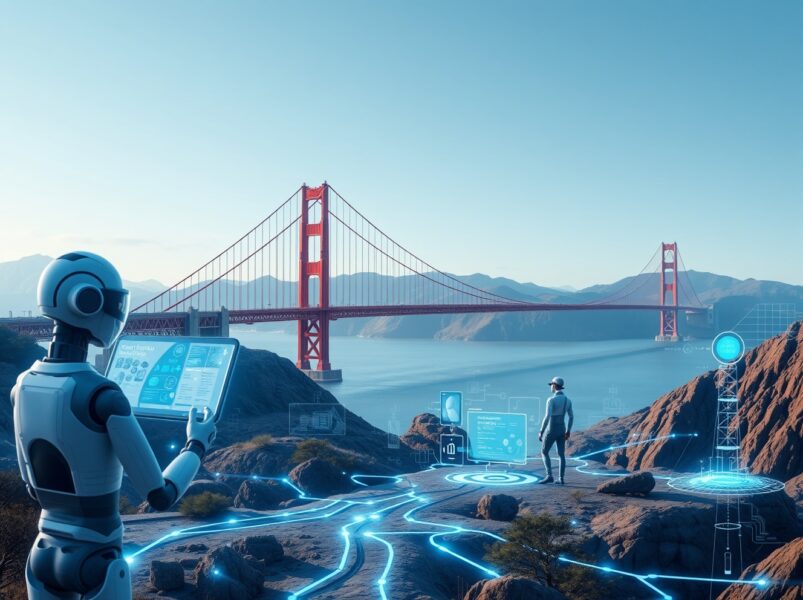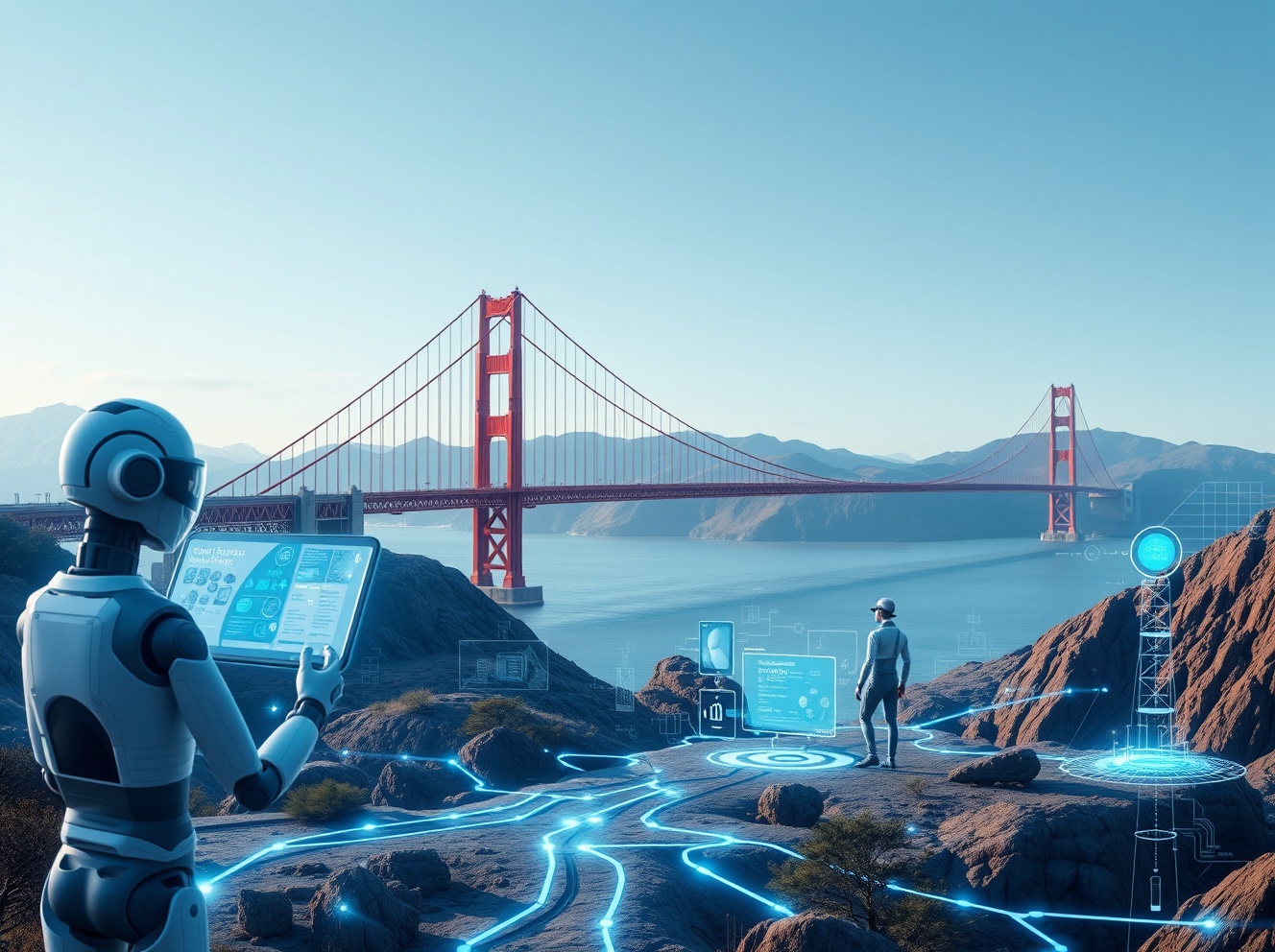Unveiling Meta AR: Crucial AI Safety Measures Emerge Amidst Tech Regulation Challenges
0
0

BitcoinWorld

Unveiling Meta AR: Crucial AI Safety Measures Emerge Amidst Tech Regulation Challenges
In the rapidly evolving landscape of digital innovation, the lines between the physical and virtual continue to blur. This week, the tech world buzzes with significant developments, from Meta’s ambitious augmented reality (AR) ventures confronting real-world hurdles to California’s renewed focus on artificial intelligence (AI) safety. For those deeply invested in the future of technology and digital economies, these shifts signal crucial implications for how we interact with technology, manage data, and navigate the regulatory maze. Join us as we unpack the latest on Meta AR, AI, robotics, and the ever-present hand of regulation that shapes our digital destiny.
Meta AR: Unpacking Reality’s Ambitious Journey
Meta’s vision for the metaverse, heavily reliant on sophisticated augmented reality (AR) and virtual reality (VR) technologies, has been a cornerstone of its strategic direction. The company has invested billions into its Reality Labs division, aiming to create immersive digital experiences that seamlessly blend with our physical world. However, as with any groundbreaking endeavor, the path is fraught with challenges.
What Challenges Does Meta AR Face in the Real World?
- Technological Hurdles: Developing lightweight, powerful AR glasses that can project convincing digital overlays onto the real world, offer wide fields of view, and boast all-day battery life remains a monumental engineering task. Miniaturization, display technology, and processing power are still evolving.
- User Adoption: Convincing a broad consumer base to embrace AR glasses as a daily accessory requires overcoming social stigmas, comfort issues, and demonstrating compelling use cases beyond gaming or niche professional applications. The ‘killer app’ for widespread AR adoption is still emerging.
- Economic Viability: The significant R&D costs and the high price point of early AR devices pose a challenge to mass market accessibility. Achieving economies of scale and reducing manufacturing costs are critical for profitability.
- Privacy Concerns: AR devices, especially those with cameras and sensors constantly scanning the environment, raise profound privacy questions. How user data is collected, stored, and utilized will be a major point of contention and regulation.
Despite these hurdles, Meta continues to push forward, understanding that the long-term potential of AR could redefine communication, commerce, and entertainment. The company’s persistent efforts in developing devices like the Quest series and future AR glasses demonstrate a firm belief in the eventual triumph of their Meta AR vision, even if the ‘reality’ of market readiness takes longer than initially projected.
Why is AI Safety Becoming a Priority? California’s Renewed Focus
As artificial intelligence becomes increasingly sophisticated and integrated into every facet of our lives, the imperative for robust AI safety measures grows stronger. California, often at the forefront of technological and regulatory trends, is once again taking a serious look at how to ensure AI systems are developed and deployed responsibly.
What Does ‘AI Safety’ Entail, and Why is it Critical Now?
AI safety refers to the field dedicated to ensuring that AI systems do not cause unintended harm, behave predictably, and remain aligned with human values and intentions. This includes preventing:
- Bias and Discrimination: AI models trained on biased data can perpetuate or amplify societal inequalities in areas like hiring, lending, or criminal justice.
- Misinformation and Manipulation: Advanced generative AI can create highly realistic fake content (deepfakes) that can be used for malicious purposes, eroding trust and stability.
- Autonomous System Failures: As AI powers self-driving cars, drones, and potentially more critical infrastructure, ensuring these systems operate without catastrophic errors is paramount.
- Job Displacement and Economic Disruption: While not a direct safety issue in the traditional sense, the societal impact of AI on labor markets requires careful consideration and policy responses.
California’s renewed attention highlights a growing consensus among policymakers and tech leaders that proactive measures are necessary. This often involves developing ethical guidelines, establishing regulatory frameworks, and funding research into explainable AI, robust AI, and value alignment. The discussions around AI safety are not just about preventing catastrophe, but about building public trust and ensuring that AI serves humanity beneficially.
Robotics Innovation: Beyond the Hype and Towards Practicality
The field of robotics continues to advance at an incredible pace, moving beyond industrial arms on assembly lines to sophisticated machines capable of complex tasks in diverse environments. From autonomous delivery robots to surgical assistants, robotics innovation is reshaping industries and daily life.
Where is Robotics Innovation Making the Biggest Impact?
| Sector | Key Innovations & Impact | Challenges |
|---|---|---|
| Logistics & Warehousing | Autonomous mobile robots (AMRs) for sorting, picking, and transporting goods, dramatically increasing efficiency and reducing labor costs. | Integration with existing infrastructure, safety protocols for human-robot interaction. |
| Healthcare | Surgical robots for precision procedures, rehabilitation robots, and automated drug delivery systems improving patient care and operational efficiency. | High cost, regulatory approval, ethical considerations for patient autonomy. |
| Agriculture | Robots for precision planting, harvesting, and crop monitoring, optimizing resource use and yield. | Operating in unstructured outdoor environments, power sources, cost for small farms. |
| Service Industry | Cleaning robots, hospitality robots (e.g., serving food), and delivery robots enhancing customer experience and operational scalability. | Public acceptance, complex navigation in dynamic human environments, maintenance. |
The convergence of AI, advanced sensors, and improved mechanical engineering is fueling this surge in robotics innovation. While the spectacle of humanoid robots often captures headlines, the true impact is being felt in more practical, specialized applications that automate repetitive, dangerous, or precise tasks, freeing up human workers for more creative and strategic roles. However, as robots become more autonomous, discussions around their ethical deployment and integration into society become increasingly important.
Navigating the Complexities of Tech Regulation
With rapid advancements in AI, AR, and robotics, the need for effective tech regulation has never been more pressing. Governments globally are grappling with how to foster innovation while protecting citizens’ rights, ensuring fair competition, and mitigating potential risks. This is a delicate balancing act, as overly restrictive regulations can stifle progress, while insufficient oversight can lead to harm.
What are the Key Areas of Focus for Tech Regulation?
- Data Privacy: Regulations like GDPR in Europe and CCPA in California set standards for how personal data is collected, processed, and stored, impacting everything from personalized ads to AI training.
- Antitrust and Competition: Governments are scrutinizing the market dominance of large tech companies, investigating potential monopolistic practices and their impact on innovation and consumer choice.
- Content Moderation: Debates rage over platforms’ responsibilities for harmful content, misinformation, and hate speech, leading to calls for greater accountability and transparency.
- AI Ethics and Governance: Beyond safety, regulations are beginning to address the ethical implications of AI, including transparency, accountability, and the prevention of algorithmic bias.
- Cybersecurity: With increased reliance on digital infrastructure, regulations aim to strengthen cybersecurity defenses, mandate reporting of breaches, and protect critical systems.
The challenge for tech regulation is to be agile enough to keep pace with technological change, yet robust enough to provide meaningful oversight. This often involves international cooperation, as technology transcends national borders, and a willingness to adapt regulations as new challenges and opportunities arise. The impact of these regulations can be profound, shaping business models, investment decisions, and the very trajectory of technological development.
What Does This Mean for Future Tech and the Digital Economy?
The interplay between Meta’s AR ambitions, the urgent calls for AI safety, the continuous march of robotics innovation, and the evolving landscape of tech regulation paints a vivid picture of our digital future. These aren’t isolated trends; they are deeply interconnected forces that will collectively shape the next generation of digital economies, including the burgeoning Web3 space.
The convergence of these technologies promises a future where digital and physical realities are increasingly intertwined. Imagine decentralized autonomous organizations (DAOs) operating within AR environments, or AI-powered robots facilitating transactions on blockchain networks. However, this future also demands a proactive approach to governance and ethics. The lessons learned from the current push for AI safety and robust tech regulation will be invaluable in building a more secure, equitable, and sustainable digital world.
For individuals and businesses alike, understanding these dynamics is crucial. It means being prepared for new forms of digital interaction, new types of data privacy challenges, and new opportunities for innovation that align with evolving societal expectations and regulatory frameworks. The decisions made today regarding these technologies will profoundly impact the digital experiences and economic structures of tomorrow.
A Glimpse into Tomorrow: Navigating the Digital Frontier
The journey into the future of technology is exhilarating yet complex. From Meta’s audacious quest to redefine human interaction through AR to California’s determined stance on AI safety, and the relentless march of robotics innovation met by the growing necessity of comprehensive tech regulation, we are witnessing a pivotal era. The conversations on podcasts like Equity, featuring experts like Anthony Ha, Kirsten Korosec, and Max Zeff, are more than just discussions; they are vital signposts guiding us through this intricate landscape. As these technologies mature, their impact on our daily lives, our economies, and our understanding of reality will only deepen. Staying informed, engaged, and critically aware of these developments is not just for tech enthusiasts, but for anyone looking to thrive in the inevitable digital future.
To learn more about the latest AI market trends, explore our article on key developments shaping AI features and institutional adoption.
This post Unveiling Meta AR: Crucial AI Safety Measures Emerge Amidst Tech Regulation Challenges first appeared on BitcoinWorld.
0
0
 Manage all your crypto, NFT and DeFi from one place
Manage all your crypto, NFT and DeFi from one placeSecurely connect the portfolio you’re using to start.




